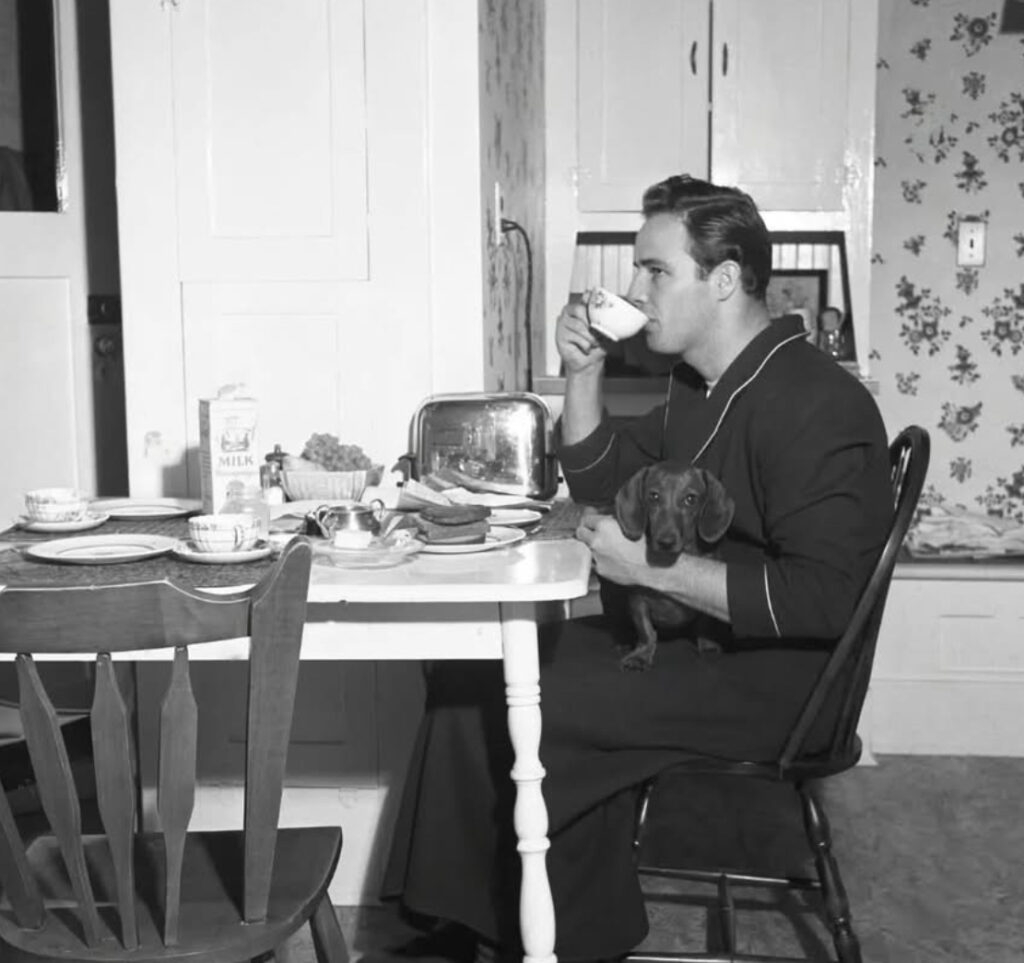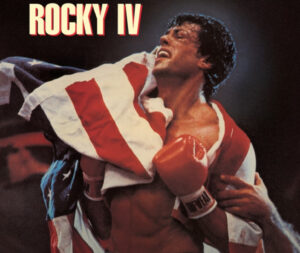In 1949, Marlon Brando was not yet the force of nature who would redefine American acting in A Streetcar Named Desire, nor the storm-eyed revolutionary of The Wild One, nor the immortal patriarch of The Godfather. He was a 25-year-old actor with just a glimmer of menace and melancholy behind his stare—a young man recently arrived in California, slowly absorbing the contradictions of fame, masculinity, and artistic responsibility.
One photograph, often overlooked in the endless archives of celebrity imagery, captures something quietly monumental. Brando, seated at a modest table in his California home, is having breakfast. No lights. No tuxedo. No motorcycle. Just the most human ritual: coffee, bread, and solitude.
In this image—unposed, unpretentious, deeply intimate—we witness a moment before the mythology calcified. A moment where Marlon Brando is not an icon, but simply a man beginning to understand the scale of his future.
A Table Set in Quiet Tension
At first glance, the setting is unremarkable. A simple breakfast table. A white mug, likely filled with black coffee. A plate with eggs or toast, barely touched. The room is sunlit in a way that suggests early morning, with light falling through half-closed blinds. Brando sits in a sleeveless undershirt, his hair slightly tousled, his gaze not aimed at the camera but somewhere just outside its frame.
He doesn’t look restless, exactly, but not at ease either. There’s tension in his posture—shoulders slightly hunched, hand wrapped absently around a fork. It’s as if he’s listening to something that’s not quite audible yet. The picture speaks not of hunger, but of waiting—for a phone call, a script, a decision.
It’s that very stillness that renders the moment cinematic. Not because anything is happening, but because everything might.
1949: On the Brink of Becoming
In 1949, Brando had only recently moved to Hollywood, having trained with Stella Adler and torn through Broadway with his raw, explosive performance as Stanley Kowalski in Tennessee Williams’ A Streetcar Named Desire. The stage had already declared him a phenomenon. Hollywood had only begun to notice.
That year, he completed filming for The Men, his first motion picture. In it, Brando portrayed a paraplegic World War II veteran—an astonishingly daring choice for a debut, and one that would foreshadow his lifelong commitment to portraying men on the margins of composure. He reportedly spent a month living at a veterans’ hospital, studying the bodily tension and psychological toll of immobility. He wasn’t interested in acting the part. He wanted to embody it.
This image of Brando at breakfast arrives just before all that acclaim hit. Before the studio machines ground into motion. Before his face was printed in millions of copies across the world. There’s a purity to this point in time: the cusp between anonymity and indelibility.
Masculinity Unscripted
Much has been written about Brando’s magnetism—about the sensual violence of his voice, the chaos behind his beauty. But in this photograph, there is no seduction. No performance. It’s masculinity without choreography—a young man not flexing, not emoting, but simply existing.
There’s something radical about that. In 1949, masculinity in Hollywood was codified by stiff suits, pressed hair, and stage-managed virility. Think Clark Gable, Gary Cooper, or John Wayne. But Brando, with his soft tank and vulnerable brow, offers something different: the masculine as vulnerable, contemplative, and unguarded.
The scene almost reads like a contradiction. Here is a man known for forceful roles and dangerous magnetism, caught instead in a moment of domestic humility. It is the anti-iconic icon—an intimate blueprint of a new kind of American male.
The Domestic as Sacred
There is a quiet holiness to domestic rituals—especially when witnessed in the lives of those who will soon become legends. Breakfast, that most democratic of routines, becomes here a sacred pause. The simplicity of the table, the light, the posture—all suggest that something more essential is being processed.
It’s not difficult to imagine Brando rehearsing lines in his head, or contemplating the moral contradictions that would later define his life. A young man who would later denounce the very industry that made him famous. Who would boycott the Oscars on behalf of Native American rights. Who would abandon and return to Hollywood in cycles of loathing and need.
This photograph, then, is not a casual snapshot. It is a still from the prelude. A sacred domestic frame capturing a man about to be devoured by the machinery of fame—and quietly, instinctively, bracing for it.
Between the Public and the Private
Celebrity, at its most corrosive, strips the subject of mystery. But Brando always resisted that erosion. He never fully gave himself to the public image. He denied interviews. He delivered chaotic acceptance speeches. He dressed sloppily. He left sets. He didn’t want to be decoded.
And perhaps that’s why this photograph endures—not for what it shows, but for what it withholds. Brando does not gaze back. He does not engage. We, the viewers, are not invited in. We are left to witness without entitlement.
The image reminds us that Brando, even in private, was unknowable. Not because he was cold, but because he refused reduction. He existed in layers. And this quiet domestic moment reveals more than many press portraits ever could: not the whole man, but a man in process.
The Future He Couldn’t Yet See
We now know what followed. A Streetcar Named Desire would catapult him to cinematic infamy in 1951. On the Waterfront would earn him an Oscar and redefine American acting. The Godfather would canonize him. And yet, fame would not soothe him. His life would tilt between performance and withdrawal, activism and exile. His personal life would be marred by tragedy and complexity.
Looking at this photograph today is to look into the eyes of a man who does not yet know the full weight of what’s coming. He has not yet mourned the failures of celebrity. He has not yet retreated to Tahiti. He has not yet become the recluse, the pariah, the prophet.
He is simply eating breakfast.
The Stillness That Lingers
What remains long after the toast is gone, after the coffee’s gone cold, is that stillness. That sense of quiet before the curtain lifts.
There is a spiritual heaviness to it—not sadness, but gravity. As if Brando already sensed that his life would not belong to him much longer. That his face would become a symbol. That his voice would be echoed, imitated, idolized, dissected.
In this photograph, there are no cues. No script. Just the calm before a cultural storm.
Impression
Seventy-five years later, the photograph endures not because of its eventfulness, but because of its restraint. It resists narrative. It resists spectacle. And in doing so, it does something quietly radical: it lets us see Marlon Brando as he was—not yet “the greatest actor of all time,” but a young man, unsure, unfinished, deeply human.
In the end, we are left with the image. A plate. A mug. A room full of light. And a man who would go on to change everything.
No comments yet.








